Judging a Roger Waters concert against any other concert experience is impossible. Even in the days when Waters was with the band Pink Floyd, the concept of a performance as performance art was paramount. They didn’t just stand there and play. Things happened in front and around the audience. This has carried on through Waters’ solo shows which have, in previous years, highlighted the albums Dark Side of the Moon and The Wall.
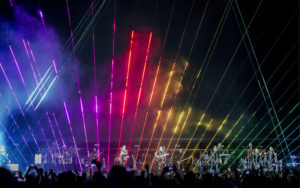 The first of a three-night stand at Philadelphia’s Wells Fargo Center, Roger Waters’ Us + Them Tour on Tuesday, August 8, once again proved why his shows are not a concert but an event, more Cirque Du Soleil than Lollapalooza.
The first of a three-night stand at Philadelphia’s Wells Fargo Center, Roger Waters’ Us + Them Tour on Tuesday, August 8, once again proved why his shows are not a concert but an event, more Cirque Du Soleil than Lollapalooza.
The Us + Them Tour has three purposes: to highlight Waters’ new album Is This The Life We Really Want, to focus on the album Animals, and to make a statement about our current culture and political events. (More on point three momentarily.) The pre-show “countdown” consisted of a rear-projection of a woman sitting on a beach, huddled in her coat with a headscarf on, looking out to the water. Over the course of fifteen minutes, this scene would shift in small increments, most of which would pass by an inattentive audience as they filed in and took their seats. To more focused observers, the sky gradually darkened in the film and the undertones of the soundtrack became more insidious. No one could know at that moment that this scene, which pulls back into a surreal million-mile aerial view, is part of a greater narrative and, in a way, the heart of the concert.
The show kicked off with side one of Dark Side of the Moon, with “One Of These Days” inserted between “Breathe” and “Time.” The vocalists Jess Wolfe and Holly Laessig of the band Lucius held down backing vocal duties, which is an understatement. When the song “The Great Gig In The Sky” rolled around, both singers were called upon to perform this incredibly difficult, wordless vocal. It is not an easy song to sing by any stretch — being able to handle the orgasmic peaks and valleys without being too exaggerated or too passive — but the singers were up to the challenge and did so in harmony.
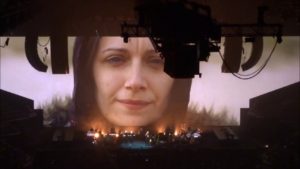 From the passionate moan to the cold, uncaring throb, “Welcome To The Machine” utilized the vintage projection animation of a steel beast roaming across desert sands, destroying all in it’s path and laying waste to humanity. The visuals resolve into those of a sea of blood and, eventually, as waves turning into hands grabbing into the sky. For some, this would be a total nostalgia trip, a golden oldie. In the context of this show, however,it is perfectly thematic. It could very easily tie into the opening scene of the woman on the beach, and will be that much more pertinent just a couple of songs from now.
From the passionate moan to the cold, uncaring throb, “Welcome To The Machine” utilized the vintage projection animation of a steel beast roaming across desert sands, destroying all in it’s path and laying waste to humanity. The visuals resolve into those of a sea of blood and, eventually, as waves turning into hands grabbing into the sky. For some, this would be a total nostalgia trip, a golden oldie. In the context of this show, however,it is perfectly thematic. It could very easily tie into the opening scene of the woman on the beach, and will be that much more pertinent just a couple of songs from now.
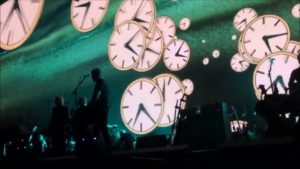 Waters had one more from the classics, the tender “Wish You Were Here,” before launching into some new songs. Is This The Life We Really Want has been characterized by critics as having too much of a parallel to older Waters compositions, and that’s a fair statement. While I like the new songs, I absolutely hear their antecedents in them. That said, the songs came alive in concert. “When We Were Young,” “The Last Refugee,” and “DÁ©jÁ Vu” help further the narrative of the woman on the beach, how she dances alone in a shack and thinks back to a time of elegance and grace. She lays down in the fetal position on sheets of cardboard. She remembers a doll. She later sees that doll at the edge of the waterline, an allusion to images of a drowned Syrian refugee child on the beach, hence “The Last Refugee.”
Waters had one more from the classics, the tender “Wish You Were Here,” before launching into some new songs. Is This The Life We Really Want has been characterized by critics as having too much of a parallel to older Waters compositions, and that’s a fair statement. While I like the new songs, I absolutely hear their antecedents in them. That said, the songs came alive in concert. “When We Were Young,” “The Last Refugee,” and “DÁ©jÁ Vu” help further the narrative of the woman on the beach, how she dances alone in a shack and thinks back to a time of elegance and grace. She lays down in the fetal position on sheets of cardboard. She remembers a doll. She later sees that doll at the edge of the waterline, an allusion to images of a drowned Syrian refugee child on the beach, hence “The Last Refugee.”
The fourth new song, “Picture That,” gets to Waters’ anger about why the human race would be, again, at this point of DÁ©jÁ Vu. He sings, “Picture a leader with no f***ing brains,” like an opening salvo. The first set closes out with the shocking sight of a line of children assembled on the stage in orange prison jumpsuits. The song is, of course, “Another Brick In The Wall (Parts 2 & 3)” and the subtext is the failure of education to actually instill a sense not just of STEM, but of right and wrong, of social responsibility, and of critical thinking in a political age that prefers citizens to gladly accept what comes down from on high without debate or dissent.
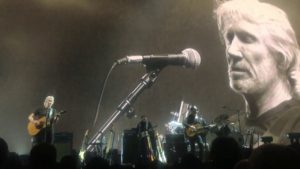 Here’s where the audience very easily could have fallen off. The argument has long stood that “I paid a lot of money to be entertained, not to have the performer(s) get all political on me. Just play me the songs.” Maybe — maybe — that train of thought could be applied to other performers who are not known to be as political as Waters, but he has been, ever since “Money,” and ever since “Welcome to the Machine.” If anyone attended a concert of his with the expectation that they weren’t going to be engaged by a message of political import, that was their fault.
Here’s where the audience very easily could have fallen off. The argument has long stood that “I paid a lot of money to be entertained, not to have the performer(s) get all political on me. Just play me the songs.” Maybe — maybe — that train of thought could be applied to other performers who are not known to be as political as Waters, but he has been, ever since “Money,” and ever since “Welcome to the Machine.” If anyone attended a concert of his with the expectation that they weren’t going to be engaged by a message of political import, that was their fault.
Set two opened in dazzling fashion as the audience was surrounded by sound effects of police calls, sirens, gun shots, etc. in a dark auditorium. Suddenly, red emergency flashers illuminate the auditorium and descend from the ceiling, almost so close to the audience that someone could have stood on their chairs and possibly touched them — they were that close. From the tops of these lightboxes emerged inflatable replicas of the Battersea power station cooling towers that doubled as projection screens. We are into the Animals portion of the show.
Animals was an interesting Pink Floyd album that had the misfortune of coming between Wish You Were Here and The Wall and was, therefore, relegated to cutout bins for years as those other two Floyd records remained cash cows. Part of this was because of the album’s lack of a concrete reason for being. “Dogs” emerged from the the song “You Gotta Be Crazy” which David Gilmour tried and failed to have included on Wish You Were Here. No one could have known that the reason it needed would arrive decades later in the form of one Donald Trump.
 Waters was able to make a meal out of the song “Pigs (Three Different Ones)” through rear projections of the U.S. president in many unflattering poses, several of which prominently featured Vladimir Putin in a particularly dominant position over Trump. He also channeled his vitriol with the song’s hook-line of “Ha ha, charade you are!” as the iconic pig drone buzzed through the stadium, defaced Banksy-style with a portrait of Trump with dollar signs for eyes, with a word balloon stating, “I won!” That written expression was inserted into the dialog that stitched together one of Pink Floyd’s most-famous songs, “Money.”
Waters was able to make a meal out of the song “Pigs (Three Different Ones)” through rear projections of the U.S. president in many unflattering poses, several of which prominently featured Vladimir Putin in a particularly dominant position over Trump. He also channeled his vitriol with the song’s hook-line of “Ha ha, charade you are!” as the iconic pig drone buzzed through the stadium, defaced Banksy-style with a portrait of Trump with dollar signs for eyes, with a word balloon stating, “I won!” That written expression was inserted into the dialog that stitched together one of Pink Floyd’s most-famous songs, “Money.”
This led to the classic “Us and Them,” the song that provided the tour its name and it’s r’aison detre. Waters is, at heart, a peacenik, even if his expression of his intentions, as opposed to the intentionss themselves, have been more controversial. For tonight, “Us and Them” was certainly the emotional center, the idea behind the drama. Can humans learn to live together even though they are different? If they can, do they even want to, and isn’t that the fatal flaw in the human experiment? Do we have the capacity to resist the drum beat to war, or to persecute and demean, or to punish the different on the basis of only the differences?
“Brain Damage” and “Eclipse” closed what would ostensibly be the second set with dazzling projections, an inflatable drone of the steel sphere which opens the “Welcome To The Machine” animation, and a laser light prism that enveloped the audience on the floor of the arena and bathed them in smoke-projected rainbow light. In an ordinary show, this would be where the band left the stage and, after the perfunctory demand for an encore, the band would emerge for a few more songs. Waters and company did not waste time by playing the game.
Hard to say for sure, but it genuinely appeared that Waters was moved by the uniformly positive response from the audience. He stood for roughly five minutes onstage in surprise and, I presume, gratitude. After all, as has already been stated, there have been a lot of stops on this tour that haven’t received the political stuff with grace. Perhaps Waters was expecting the crowd to be receptive to the message, but not this receptive. But the show must go on…
“Vera,” “Bring the Boys Back Home,” and the absolutely necessary “Comfortably Numb” closed the music portion. On the screen, there too was narrative closure. We’re back to the woman on the beach, looking out at the water, wondering what they’ve taken from her. But then from the left of the screen, a young child emerges to join her mom and watch the waves roll in.
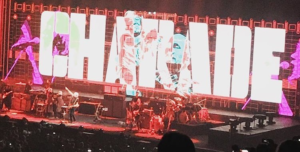 So we’ve talked a lot about the content of the show versus the performances. It is fair to say that Waters would not take out a band that couldn’t perform the task. This was one of the traits that, according to many a published account, caused constant friction inside the Pink Floyd organization. The songs were presented incredibly close to their original state, and while that is often a detriment to a live performance, this is not your typical concert. The music is the largest part of the puzzle, but still just a part. The whole is a combination of the props, the visuals, the way sound affects the audience. For instance, to punctuate the re-imagined intent for “Another Brick In the Wall Part 2” as a statement of education’s failure to serve children’s full intellectual and cultural needs, the arena was darkened, then flash-lit by a screen projection of a hundred flash bulbs going off at once, accompanied by a thunderous sound. You could feel the sound, and you were meant to. This impromptu mugshot photo shoot was meant to shock you awake.
So we’ve talked a lot about the content of the show versus the performances. It is fair to say that Waters would not take out a band that couldn’t perform the task. This was one of the traits that, according to many a published account, caused constant friction inside the Pink Floyd organization. The songs were presented incredibly close to their original state, and while that is often a detriment to a live performance, this is not your typical concert. The music is the largest part of the puzzle, but still just a part. The whole is a combination of the props, the visuals, the way sound affects the audience. For instance, to punctuate the re-imagined intent for “Another Brick In the Wall Part 2” as a statement of education’s failure to serve children’s full intellectual and cultural needs, the arena was darkened, then flash-lit by a screen projection of a hundred flash bulbs going off at once, accompanied by a thunderous sound. You could feel the sound, and you were meant to. This impromptu mugshot photo shoot was meant to shock you awake.
More than the effects, there are moments in the music of Pink Floyd that are just beautiful, and that can easily be overlooked for the visceral moments. “Us and Them” is a gorgeous song, as is “Comfortably Numb,” even if it is profoundly depressing in terms of subject matter. “The Great Gig In The Sky” is intended to be emotionally moving. Without the glamor and stagecraft, the songs would still hold up, and that’s what matters.
A few final thoughts are necessary. This has little to do with the concert than it does with concert culture which is at a low presently. I attended the show with a friend and I wanted to be sure she had a great experience. I believe she did, but the “gentleman” sitting next to her didn’t much care for her experience or anyone else’s. In fact, he spent most of the time video recording the show. He attempted early in the performance to put his phone on a selfie stick to record the entire show. (Special thanks to the gentleman behind him who told him to not be a jerk. The selfie stick went away.)
People want a record to show that they were at a concert. Part of the fun is in the bragging rights, and cell phone technology has made this a real-time conversation with the outside world. And that’s fine. Take a few pictures, shoot a minute or two of video, but be considerate enough to put the phone away MOST of the time and enjoy the show as-is…or don’t screw it up for everyone else. There’s no irony in needing to make that statement — don’t screw it up for everyone else — during a show where the underlying sentiment for the better part of it was exactly that. It only illustrates how selfish the culture can be, and how communication is so fatally flawed when one (or both) of the participants in the conversation doesn’t really care and just wants what they want.
This should be obvious, for small coffeehouse performances and big-budget spectacles alike, to get your document of being present, maybe take a few shots of the most interesting moments, but also be considerate. This individual didn’t ruin the show. It would have taken a lot more than his thoughtlessness to accomplish that, but in our modern era where you cannot ban recording devices anymore because they’re more than just recording devices, a little self-responsibility should be a given.





Comments